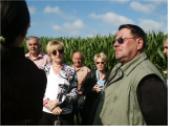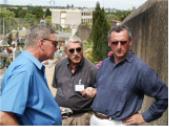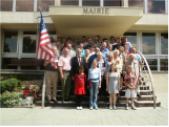|
5-July-2004 - Day 3
We rendezvous at the now familiar Saint Colomban Hôtel de Ville or town hall and assemble our caravan of autos. Jessica Viaud is our official translator today and is assisted by Corrine Pouvreau and Didier Giraudeau, who continue to be our guardian angels throughout our visit, attending to our every need.
 Our first stop is the field where Ralph McKee's parachute landed. Our narrator is Raymond Pouvreau, the father of Corinne Pouvreau, who was seven at the time of the B-17 crash. He heard the story many times from Marcel Biret, his family's good friend. Corinne's father tells how Marcel Biret and Celestin Dugast spotted the parachute and quickly bicycled to the Air Force Lieutenant. Marcel grabbed the parachute and hid it at the base of a tree, while Celestin motioned for Ralph McKee to get on Marcel Biret's bike and ride away before the Germans come. They ride down a small road between some farmhouses and several trucks of German soldiers pass them. In their haste to get the flyer whose parachute they have seen, the Germans drive right by the two men on bicycles, one in a flight suit! With pounding hearts Ralph and Celestin continue on their bicycles until Celestin decides to quickly cut across a field and get off the road. It must have been a rough ride for both men and particularly, Ralph, who has a fractured vertebra. On foot, we trace the path the men rode on their bicycles 61 years ago, up to the field they cut across. We are filled with emotion to be walking down this same road our father was on sixty-one years ago, so close to being captured by German soldiers. Our first stop is the field where Ralph McKee's parachute landed. Our narrator is Raymond Pouvreau, the father of Corinne Pouvreau, who was seven at the time of the B-17 crash. He heard the story many times from Marcel Biret, his family's good friend. Corinne's father tells how Marcel Biret and Celestin Dugast spotted the parachute and quickly bicycled to the Air Force Lieutenant. Marcel grabbed the parachute and hid it at the base of a tree, while Celestin motioned for Ralph McKee to get on Marcel Biret's bike and ride away before the Germans come. They ride down a small road between some farmhouses and several trucks of German soldiers pass them. In their haste to get the flyer whose parachute they have seen, the Germans drive right by the two men on bicycles, one in a flight suit! With pounding hearts Ralph and Celestin continue on their bicycles until Celestin decides to quickly cut across a field and get off the road. It must have been a rough ride for both men and particularly, Ralph, who has a fractured vertebra. On foot, we trace the path the men rode on their bicycles 61 years ago, up to the field they cut across. We are filled with emotion to be walking down this same road our father was on sixty-one years ago, so close to being captured by German soldiers.
By car we go to the old Biret farmhouse. It is now owned by someone else and the committee has been unable to reach the owners, so we are content to look through the gate and take photos of the outside of the house including the hay loft where Ralph spent his first exhausted night. During the day in July of 1943, the Biret's moved the young lieutenant to some hedgerows for safety. Indeed the next day and for several days thereafter, their home was visited by German soldiers looking for the American flyer. It was decided that the American should be moved the next day as it was dangerous to keep him too long in one place.
Ralph was placed in a wagon and a small load of hay was thrown over him. A horse pulled the wagon out of the farmyard over roads and through a field. The two boys had their fishing poles so it appeared they were on their way to fish. Ralph was left on the edge of a marsh with some bread and cheese and a bottle of wine. This same cart later moved him to another farmhouse.
On our way to the second farmhouse, our caravan stops to view a lake with a lovely chateau on the shore. A German fighter plane was shot down and went into this lake on 4-July-1943. The plane was more than likely brought down by one of the crewmembers of B-17 #42-5053. Perhaps one of the crewmen should get credit for gunning down this German plane! Several years ago, some local historians had plans to recover the German plane and contacted the pilot's family for permission, as the pilot's remains are still in the wreckage. The pilot's family agreed, but the French government was not in agreement and the wreckage remains in the lake.
We drive to the hamlet La Hairiau to visit the farmhouse of Joseph Guillet, whose wife is the niece of J. Baptist Guilbaud, now deceased. Monsieur Guilbaud's four nieces are at the farmhouse with their families to greet us. They show us where Ralph was hidden near a compost pile (now a garden) and under the wine press. They give us maps they have marked to show the route that Ralph has taken to get to their uncle's farmhouse. The family is very proud of the role they played in the rescue of an American flyer; and again we are filled with emotion at the brave French men and women who risked their lives to help Ralph McKee escape to freedom. After several days at the Guilbaud farmhouse, the Resistance was finally contacted and six days after his airplane was shot down, Ralph left the Guilbaud farm and was taken to the town of Basse-Indre (now Indre).
 We drive to the ferry to take us to Indre. As our caravan of cars exits the ferry, several cars full of the Ligonday family meet us. Joël stuns us by pulling out what first looks like a silk scarf, but is actually a map of France printed on silk. Joël tells us that our father, Ralph McKee, left this part of his escape kit behind at the Ligonday home when he departed for Spain. We drive to the ferry to take us to Indre. As our caravan of cars exits the ferry, several cars full of the Ligonday family meet us. Joël stuns us by pulling out what first looks like a silk scarf, but is actually a map of France printed on silk. Joël tells us that our father, Ralph McKee, left this part of his escape kit behind at the Ligonday home when he departed for Spain.
We park our cars and walk to 1 rue Charles Laisant which in 1943 was the shop and home of the town chemist and Resistance organization member, Jean Ligonday. Jean and his friend Felix Guyot will eventually help twelve Americans escape from the Germans. We walk a path from the chemist shop to the former grocery shop of Felix Guyot, and learn that Ralph and pilot, Bill Wetzel walked this same path in the dark of night to attend several of the Résistance planning meetings that plotted to find a way to get them safely out of France.
 We walk to Place Jean Ligonday, the street that has been named for the father of Danielle and Joël. The sign also reads Résistant - Déporté, ler-11-1907 to 9-11-1974. We continue our walk through Indre and pass a sign "Stade F. Guyot" indicating the direction to the town's stadium that has been named for Felix Guyot. As we head up a steep hill toward the town's church we see a huge American Flag flying in our honor. We walk to the church cemetery to visit the burial place of this famous freedom fighter, Jean Ligonday, and reverently pay our regards to a man so instrumental in saving our father's life. Several months after helping Ralph and Bill escape, Jean was thrown into prison for fifteen months and tortured to give the names of other resistance members, which he did not do. We walk to Place Jean Ligonday, the street that has been named for the father of Danielle and Joël. The sign also reads Résistant - Déporté, ler-11-1907 to 9-11-1974. We continue our walk through Indre and pass a sign "Stade F. Guyot" indicating the direction to the town's stadium that has been named for Felix Guyot. As we head up a steep hill toward the town's church we see a huge American Flag flying in our honor. We walk to the church cemetery to visit the burial place of this famous freedom fighter, Jean Ligonday, and reverently pay our regards to a man so instrumental in saving our father's life. Several months after helping Ralph and Bill escape, Jean was thrown into prison for fifteen months and tortured to give the names of other resistance members, which he did not do.
Next we continue on to the Indre Hôtel de Ville or Town Hall, where we are warmly greeted by the mayor for yet another vin d'honneurs. Maire (Mayor) Aleide Maquire informs us that the American flag we saw is the first to ever be raised in Indre, and he is very proud of our visit. Apparently it was quite a task to produce two large American flags with just four days notice.
After wine, toasts and receiving a medal for Ralph McKee, Danielle and Joël Ligonday present the McKee's with some gifts. Danielle recounts the story that when Ralph McKee and Bill Wetzel were hidden in her home, they acquired a taste for cherry brandy. She surreptitiously supplied the young fliers with as much as they wanted, until her parents discovered her deeds. She presents us with a bottle of cherry brandy to take home for Ralph McKee and carries her doll she has named Ralphaela in honor of Ralph.
 We assemble on the steps of the town hall for photos with the second American flag, and are presented with copies of the photo about ten minutes later. Suddenly, it is time to go as Larry, Vicki and Garry McKee need to catch the TGV (Fast Train) in Nantes back to Paris. We assemble on the steps of the town hall for photos with the second American flag, and are presented with copies of the photo about ten minutes later. Suddenly, it is time to go as Larry, Vicki and Garry McKee need to catch the TGV (Fast Train) in Nantes back to Paris.
We tearfully say good-bye to our new French friends with a renewed faith in the goodness of man and a respect for the French people who want to keep history and the memories of their liberation alive. We vow to return and see everyone soon. A Bientôt!
[Back]
|
|

